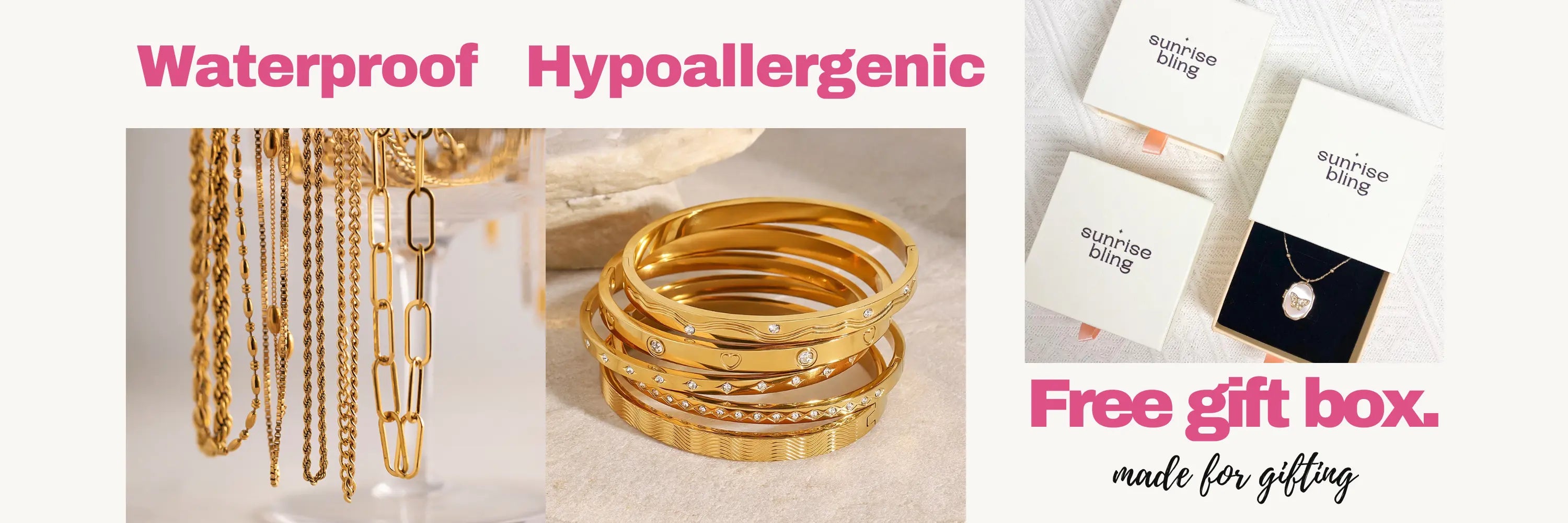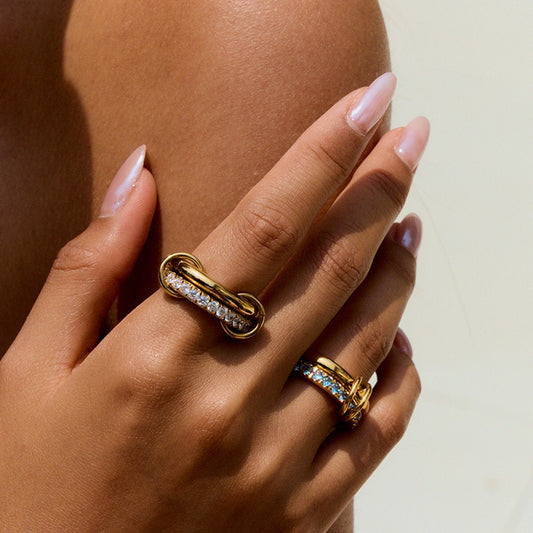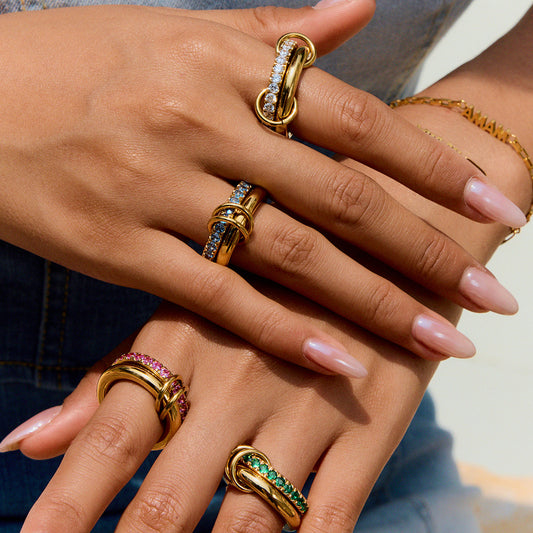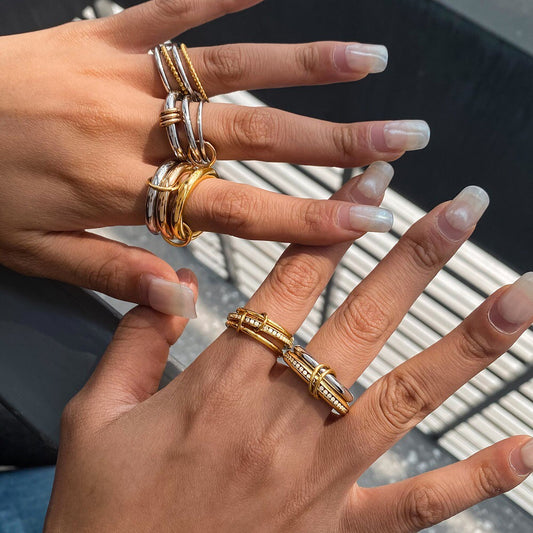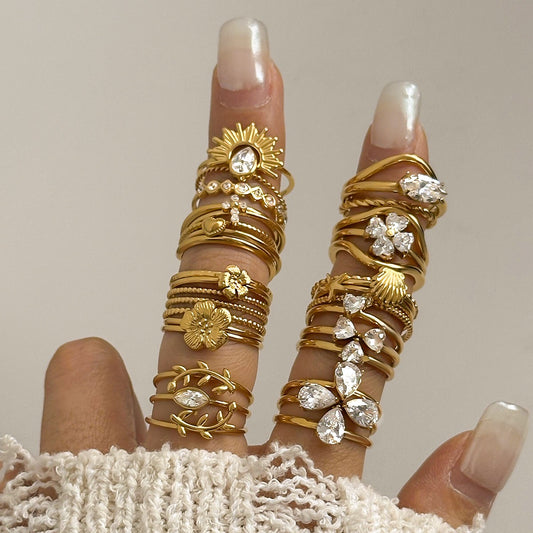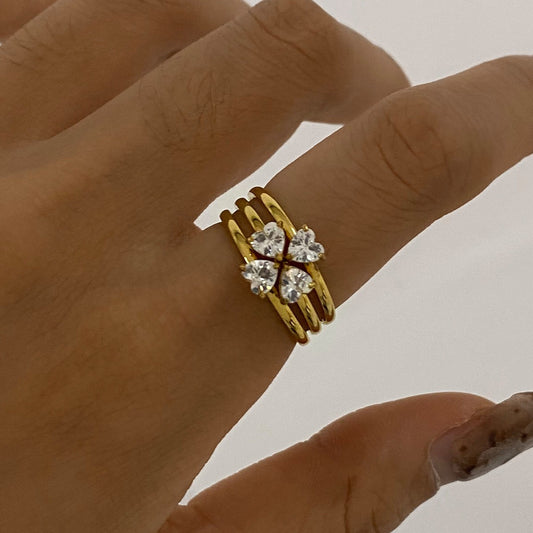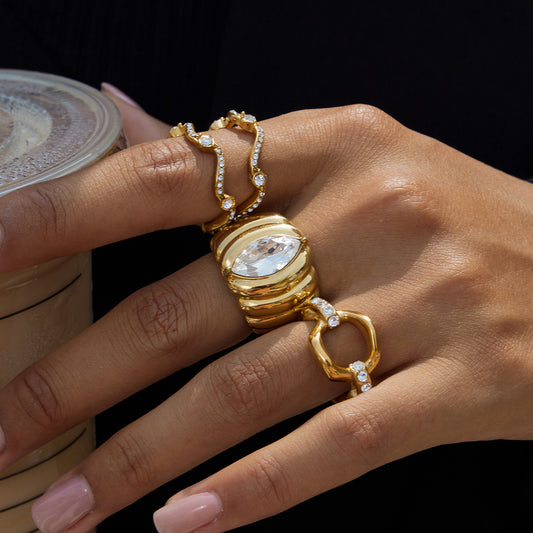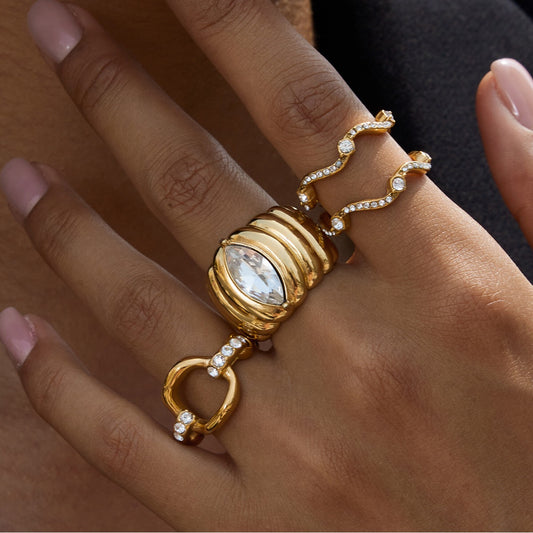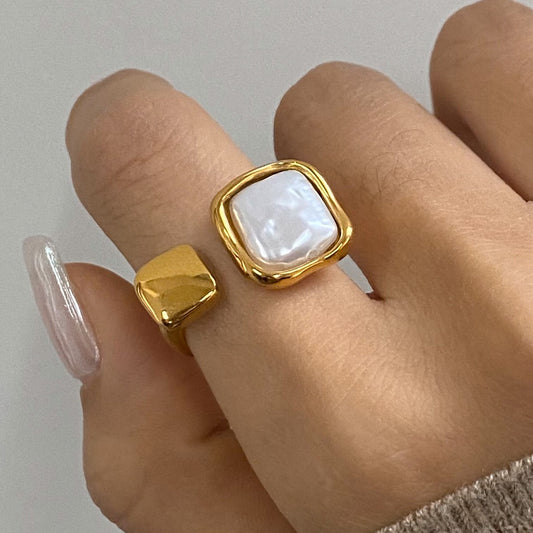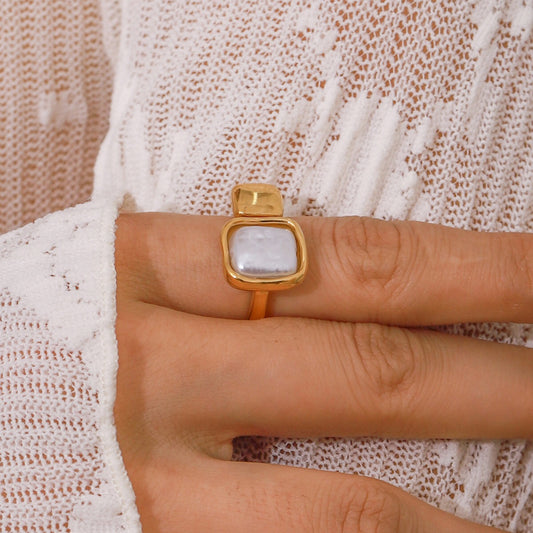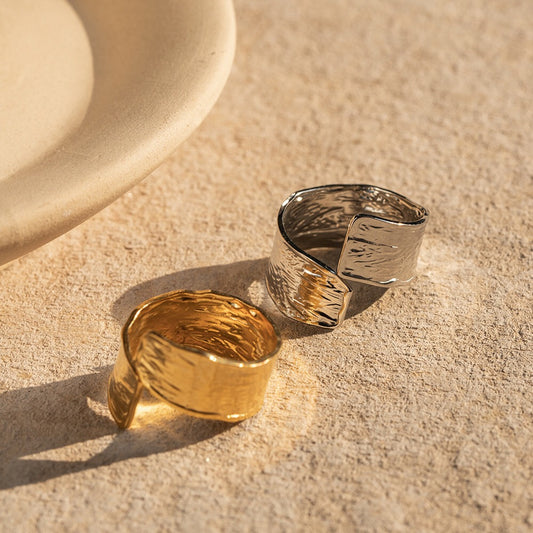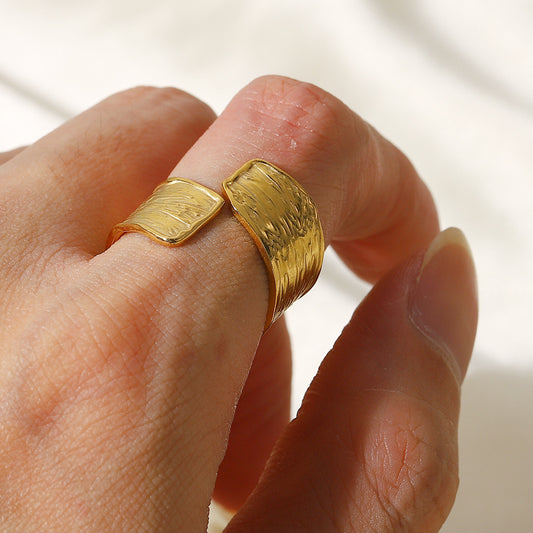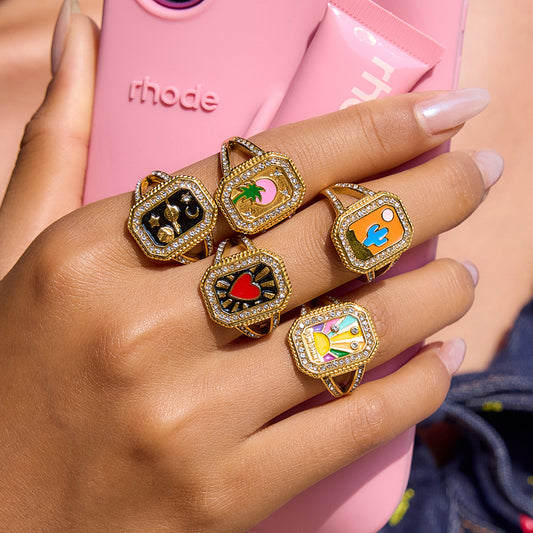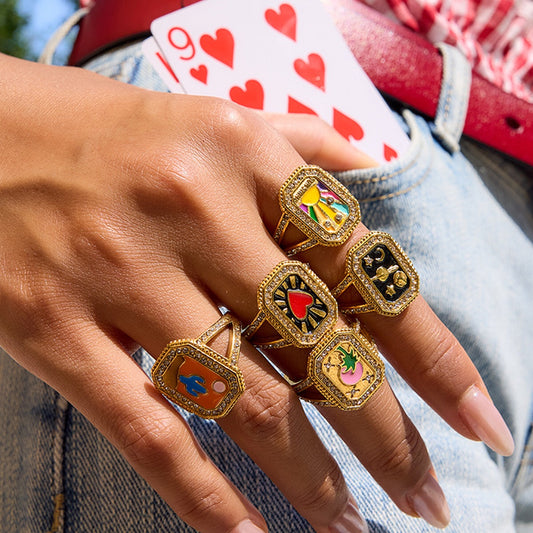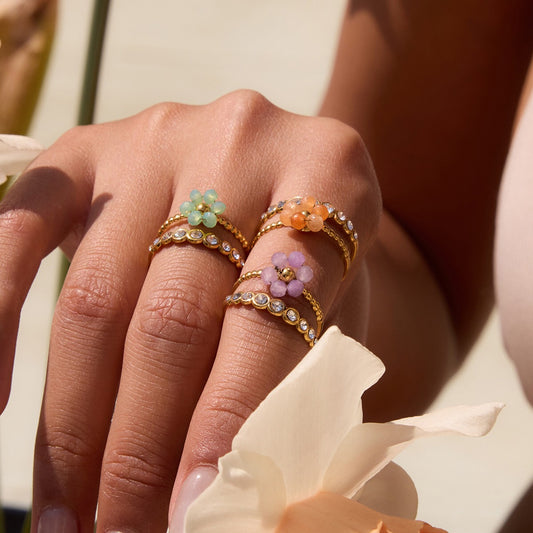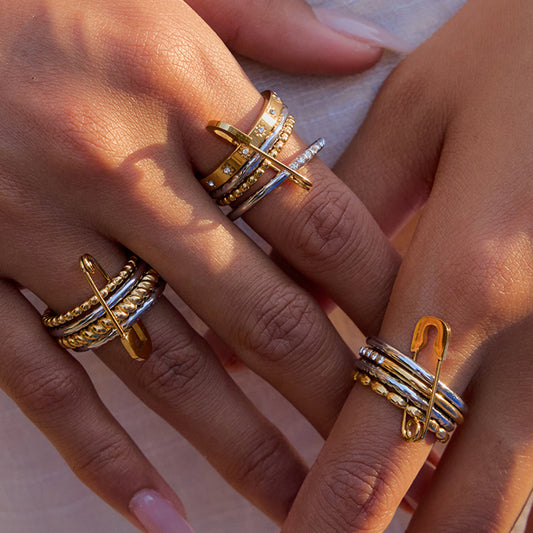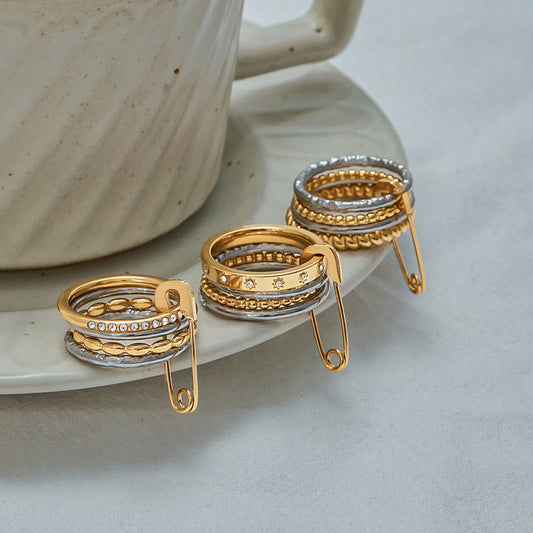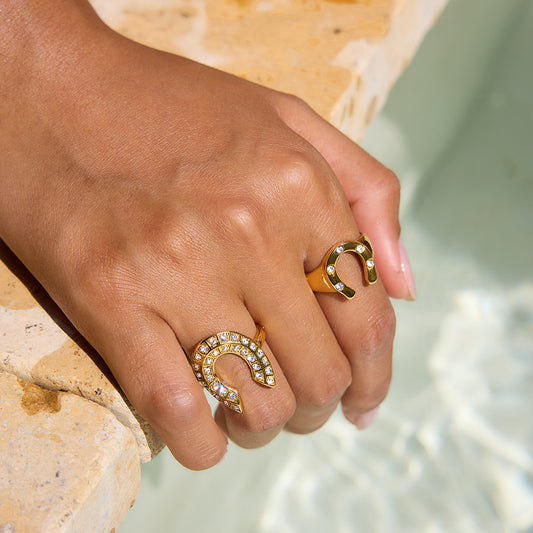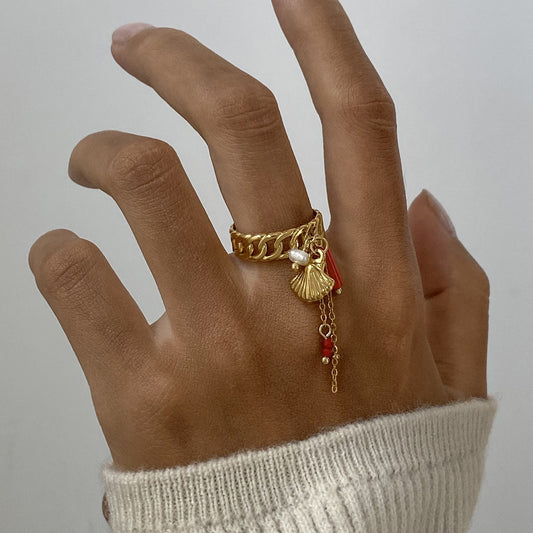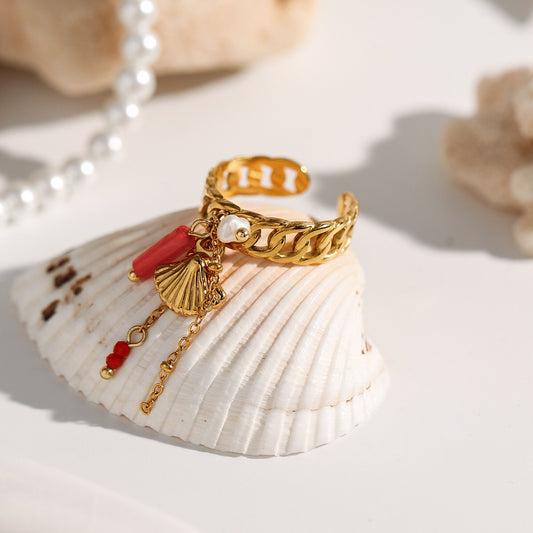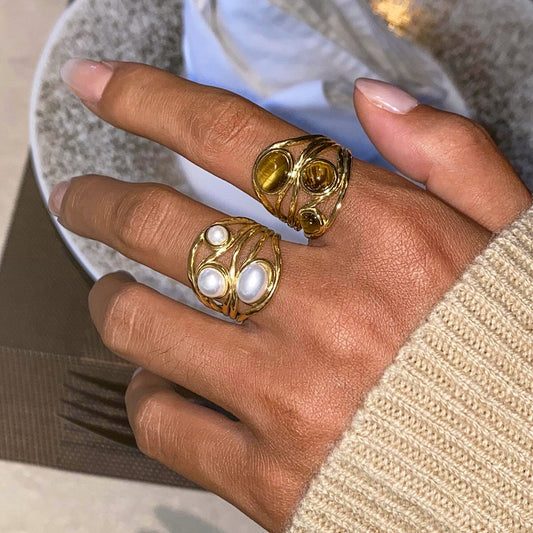Opal in Ring designs have captured jewelry lovers’ attention with their otherworldly iridescence—those shifting flashes of color (called “fire”) that make each opal one-of-a-kind. United States Opal Ring Market size was valued at USD 0.3 Billion in 2024 and is projected to reach USD 0.5 Billion by 2033. Unlike diamonds or sapphires, which rely on sparkle alone, opals tell a visual story—their play of color (ranging from soft pastels to bold rainbows) adds a whimsical, personal touch to any outfit. Whether you’re wearing a dainty white opal solitaire for coffee runs or a bold black opal cocktail ring for date night, an opal in ring isn’t just jewelry—it’s a wearable piece of nature’s art. This guide covers everything you need to know about opal in ring designs, from their origins to how to style, care for, and authenticate them.

What Is Opal in Ring?
An “opal in ring” refers to any ring design where an opal gemstone is the central or accent feature, set in a metal band (typically gold, silver, rose gold, or platinum) to highlight the opal’s unique iridescence. Opals themselves are hydrated silica gemstones (formed from mineral-rich water seeping into rock cracks) and are prized for their “play of color”—the rainbow-like flashes that appear when the stone is tilted.
Unlike other gemstones (which have a consistent color), opals are defined by their variability: no two opals have the same pattern of fire, making every opal in ring completely unique. These rings range from minimalist solitaries (a single opal cabochon) to elaborate vintage-inspired designs (opal surrounded by small diamonds or colored gemstones), with settings tailored to protect the opal (a relatively soft gemstone) while showcasing its beauty.
Key Characteristics of Opal in Ring
-
Types of Opals Used in Rings:
-
White Opal (Light Opal): The most common type—light gray or white base color with pastel flashes of pink, blue, or green. Affordable and versatile, perfect for everyday rings (studios, pendants, solitaries).
-
Black Opal: The rarest and most valuable—dark gray or black base color with vivid, bold fire (red, orange, blue). Mined primarily in Australia, black opal in ring designs are often statement pieces (cocktail rings, engagement rings).
-
Boulder Opal: Formed attached to ironstone boulders—features a mix of opal and rock, creating a rustic, earthy look. Popular for men’s opal rings or bohemian-style women’s rings.
-
Crystal Opal (Water Opal): Translucent or semi-transparent with bright, clear fire. Lightweight and delicate, ideal for dainty ring designs (stacking rings, small solitaries).
-
Opal Quality Factors:
-
Play of Color: The most important factor—brighter, more varied flashes (e.g., red and orange, which are rarer than blue) increase value. The fire should be visible from multiple angles, not just one.
-
Base Color: Darker base colors (black, dark gray) make fire more vivid, so black opals are more valuable than white opals.
-
Clarity: Opals often have natural inclusions (called “matrix” or “veins”), but excessive cracks or cloudiness lower quality. For rings, “eye-clean” opals (no visible flaws to the naked eye) are preferred.
-
Shape/Cut: Most opals in rings are cut as cabochons (smooth, rounded tops with flat bottoms)—this shape maximizes play of color. Fancy cuts (oval, pear) are less common but used for statement rings.
-
Ring Settings for Opals:
-
Bezel Setting: A thin metal rim wraps around the opal, holding it securely. The best choice for opal in ring designs—protects the opal’s edges (prone to chipping) and is ideal for everyday wear.
-
Prong Setting: 3–4 small prongs hold the opal in place, exposing more of the stone to light. Best for higher-quality opals (to showcase fire) but less protective—better for occasional wear.
-
Halo Setting: The opal is surrounded by small diamonds or colored gemstones (e.g., sapphires), which enhance its fire and add sparkle. Popular for engagement or special-occasion opal rings.
-
Vintage Setting: Intricate metalwork (filigree, milgrain edges) paired with opal—common in Art Deco or Victorian-inspired designs. Adds nostalgia and elegance, perfect for those who love retro style.

How Opal in Ring Differs from Other Gemstone Rings
-
Uniqueness: No two opal in rings are the same—each opal’s fire pattern is distinct. Other gemstones (diamonds, sapphires) can be identical in color and cut.
-
Softness: Opals score 5–6.5 on the Mohs scale (softer than diamonds, sapphires, or even pearls), requiring more careful handling. This means opal in ring settings prioritize protection (bezel over prong).
-
Color Story: Opals’ play of color adds depth and movement—unlike solid-colored gemstones, they shift with light, making the ring feel dynamic and alive.
Why Is Opal in Ring So Popular?
Opal in ring designs have surged in popularity because they offer something no other gemstone ring can: a blend of natural beauty, uniqueness, and emotional resonance. Their appeal spans styles—from minimalists to bohemians, vintage lovers to trendsetters—and is rooted in several key factors:
One-of-a-Kind Iridescence
Opals’ play of color is unlike any other gemstone—those flashes of blue, pink, red, or orange feel magical, like carrying a tiny rainbow on your finger. In a world of mass-produced jewelry, an opal in ring stands out as a unique piece: you’ll never see someone else wearing the exact same opal pattern. This exclusivity makes it feel personal, like a piece of jewelry tailored just for you.
Versatile Style for Every Occasion
Opal in ring designs adapt to any look, from casual to formal:
-
Everyday Casual: A small white opal bezel-set ring in silver pairs with jeans, t-shirts, and sneakers—adds a subtle pop of color without feeling dressy.
-
Work/Professional: A delicate crystal opal stacking ring in rose gold complements blazers and tailored trousers—polished enough for meetings but not distracting.
-
Formal Events: A black opal halo ring with diamonds elevates gowns or cocktail dresses—its bold fire becomes a conversation starter at weddings or galas.
This versatility means you can wear your opal in ring daily, not just for special moments.

Rich Symbolism & Sentiment
Opals have been associated with meaning across cultures for centuries:
-
Creativity & Inspiration: Ancient Greeks believed opals sparked creativity, making them a favorite for artists and writers.
-
Love & Loyalty: In Victorian times, opals were given as tokens of love—their unique fire symbolized a one-of-a-kind relationship.
-
Hope & Joy: Modern cultures see opals as a symbol of positivity, with their bright fire representing optimism.
This symbolism adds emotional weight to opal in ring designs—they’re not just accessories, but reminders of what matters most.
Accessibility for Every Budget
While rare black opals can be expensive, most opal in ring designs are surprisingly affordable:
-
Budget-Friendly: White opal bezel-set rings in sterling silver—\(50–\)200.
-
Mid-Range: Crystal opal or boulder opal rings in 14k gold—\(200–\)800.
-
Luxury: Black opal halo rings with diamonds in 18k gold—\(800–\)5,000+.
This range means anyone can own an opal in ring, whether they’re buying their first piece or investing in a heirloom.
Trendy Yet Timeless
Opal in ring designs have trending appeal (seen on celebrities like Taylor Swift and Zendaya) but don’t feel fleeting. Their natural beauty and vintage-inspired roots keep them relevant— a white opal solitaire bought in 2024 will look just as elegant in 2044. They bridge the gap between on-trend and classic, making them a smart addition to any jewelry collection.

Popular Styles of Opal in Ring
Opal in ring designs cater to every taste, from minimalist to bold. Below are the most in-demand styles, each highlighting opals’ unique fire in different ways:
White Opal Bezel-Set Solitaire (Everyday Essential)
The most popular opal in ring style—simple, durable, and versatile:
-
Design: A small white opal cabochon (6–8mm) set in a thin bezel of sterling silver or 14k gold (yellow, rose, or white). The band is slim (1–2mm) for comfort, making it ideal for daily wear.
-
Best For: Casual outings, work, or anyone new to opal jewelry. Perfect for stacking with thin metal bands.
-
Why It’s Popular: The bezel setting protects the opal (critical for everyday use), and the white opal’s soft fire adds a subtle pop of color to any outfit. It’s affordable, low-maintenance, and timeless.
Black Opal Halo Ring (Statement & Luxury)
A showstopping style for special occasions or those who love bold jewelry:
-
Design: A medium black opal cabochon (8–10mm) surrounded by a halo of tiny diamonds (0.10–0.25 TCW) or sapphires. Set in 14k or 18k white gold (to enhance the opal’s dark base and vivid fire).
-
Best For: Engagements, anniversaries, or formal events. Popular with those who want a unique alternative to diamond engagement rings.
-
Why It’s Popular: The black opal’s bold fire paired with the halo’s sparkle creates a luxurious look that stands out without being over-the-top. It’s a statement piece that feels special and meaningful.
Vintage Filigree Opal Ring (Retro Charm)
A nostalgic style inspired by Art Deco or Victorian eras:
-
Design: A small to medium opal (white or crystal) set in an intricate filigree band (sterling silver or 14k yellow gold). The band features detailed metalwork (twists, scrolls, or milgrain edges) that adds vintage elegance.
-
Best For: Brunch, weddings, or anyone who loves retro or bohemian style. Popular with collectors of vintage jewelry.
-
Why It’s Popular: The filigree metalwork complements the opal’s soft fire, creating a romantic, timeless look. It feels like a heirloom piece, even if it’s new.
Boulder Opal Rustic Ring (Earthy & Unique)
A rugged, natural style for those who love organic designs:
-
Design: A boulder opal (still attached to its ironstone matrix) set in a thick, rustic metal band (sterling silver or 14k rose gold). The opal’s fire contrasts with the rough stone and metal, creating an earthy, bohemian vibe.
-
Best For: Outdoor events, concerts, or men’s opal rings. Popular with those who prefer “unpolished” or artisanal jewelry.
-
Why It’s Popular: No two boulder opal rings are the same—the ironstone matrix adds texture and uniqueness. It’s a bold, casual style that feels authentic and one-of-a-kind.
Opal Stacking Ring (Delicate & Playful)
A tiny, versatile style for layering:
-
Design: A micro opal cabochon (3–5mm) set in a thin, adjustable band (sterling silver or 14k gold). The band is lightweight and flexible, making it easy to stack with other rings.
-
Best For: Everyday wear, layering with other stacking rings (metal or gemstone). Popular with teens and young adults.
-
Why It’s Popular: It’s affordable, playful, and easy to mix and match. The tiny opal adds a subtle flash of color to a stacked look, without overwhelming other rings.

How to Wear Opal in Ring
Wearing an opal in ring is all about highlighting its unique fire while fitting your personal style. Below are tips for different occasions, stacking strategies, and outfit pairings:
Styling for Different Occasions
-
Everyday Casual:
-
Solo Bezel-Set Solitaire: Wear a white opal bezel-set ring (silver or rose gold) on your ring finger with a white t-shirt, high-waisted jeans, and sneakers. Keep other jewelry minimal (small stud earrings, a thin necklace) to let the opal’s fire shine.
-
Stacked Opal + Metal Rings: Layer a tiny opal stacking ring with 1–2 thin metal bands (e.g., a silver band + a rose gold band) on your index finger. Pair with a sweater, leggings, and ankle boots for a cozy, chic look.
-
Work/Professional:
-
Delicate Crystal Opal Ring: Wear a crystal opal ring (14k gold bezel) on your middle finger with a tailored blazer, button-down shirt, and trousers. It’s polished enough for client meetings but subtle enough to avoid distraction.
-
Opal + Small Diamond Ring: A white opal ring with tiny diamond accents pairs with a sheath dress or pencil skirt. The diamonds add subtle sparkle, making it appropriate for formal work events.
-
Formal Events:
-
Black Opal Halo Ring: Wear a black opal halo ring on your ring finger with a floor-length gown (black, navy, or emerald green). Skip other hand jewelry—let the opal’s bold fire be the focal point.
-
Vintage Filigree Opal Ring: A Victorian-inspired opal ring pairs with a lace or velvet dress for weddings, galas, or holiday parties. Add small pearl earrings to complement the retro vibe.
Stacking Tips for Opal in Ring
Stacking opal in rings with other jewelry is a fun way to add depth—follow these rules to avoid overwhelming the opal’s fire:
-
Stick to Thin Bands: Pair opal in rings with thin metal bands (1–2mm) or other delicate gemstone rings (e.g., tiny sapphire or ruby stacking rings). Thick bands will overshadow the opal’s subtlety.
-
Mix Metals Strategically: Opal in rings work with any metal—try mixing silver and rose gold for a trendy look, or keep it cohesive with all gold. For example: white opal in silver + rose gold band + silver band.
-
Limit to 3–4 Rings Per Hand: Too many rings will clutter the look—focus on 1 opal in ring + 2–3 complementary rings. Place the opal ring on a different finger than bulkier rings (e.g., a cocktail ring) to balance the weight.
Outfit Color Pairings for Opal in Ring
Opals’ variable fire pairs with nearly any color—here’s how to make their flashes pop:
-
Neutrals (Black, White, Gray, Beige): Opals’ fire stands out against neutrals—white opal in silver pairs with a white blouse and black jeans; black opal in gold pairs with a beige sweater and gray pants.
-
Soft Pastels (Pink, Blue, Lavender): White or crystal opals complement pastels—their soft fire enhances the outfit’s sweetness. Try a crystal opal ring with a pink sundress or lavender skirt.
-
Bold Colors (Red, Emerald Green, Cobalt Blue): Black opals shine with bold colors—their dark base contrasts with bright hues, making the opal’s fire (especially red or orange flashes) pop. Wear a black opal ring with a red dress or emerald green blazer.
Opal in Ring: Perfect Gift for Your Girlfriend
An opal in ring is one of the most thoughtful gifts you can give your girlfriend—it’s unique, personal, and packed with sentiment, showing you’ve paid attention to her style and personality. Unlike generic gifts (jewelry boxes, scarves), an opal in ring is a wearable reminder of your love, perfect for birthdays, anniversaries, or “just because” moments.
Why It Resonates as a Girlfriend Gift
-
Uniqueness: No two opal in rings are the same—gifting one says, “You’re one-of-a-kind, and I see that.” It feels personal, not like a last-minute purchase.
-
Sentiment: Opals symbolize love, creativity, and joy—aligning with the feelings you have for your girlfriend. Every time she wears the ring, she’ll think of the moment you gave it to her.
-
Versatility: She’ll wear it daily, not just store it away—whether she’s into casual, professional, or bohemian style, there’s an opal in ring that fits her wardrobe.
Top Opal in Ring Gifts for Your Girlfriend
-
14k Rose Gold White Opal Bezel Ring: A small white opal (6mm) set in a thin rose gold bezel. The rose gold enhances the opal’s soft pink and blue flashes, and the bezel setting is durable for daily wear. Perfect if she loves delicate, feminine jewelry.
-
Sterling Silver Vintage Filigree Opal Ring: A crystal opal set in an intricate silver filigree band. The retro design feels romantic, and the silver
complements the opal’s clear fire. Ideal if she loves vintage or bohemian style—pair it with a handwritten note about why the retro design reminds you of her (e.g., “This ring’s unique charm matches yours”).
-
14k Yellow Gold Black Opal Mini Halo Ring: A small black opal (5mm) with a tiny diamond halo, set in yellow gold. It’s a subtle luxury piece—sparkly enough for special occasions but understated enough for everyday wear. Perfect for anniversaries or milestone moments (e.g., her promotion).
Tips for Choosing the Right Opal in Ring for Your Girlfriend
-
Match Her Style: If she prefers minimalism, go for a white opal bezel solitaire. If she loves bold pieces, a black opal halo ring is better. For retro lovers, a vintage filigree design is ideal.
-
Consider Her Lifestyle: If she’s active (yoga, hiking), choose a bezel setting (more protective) and a durable metal like 14k gold. If she works in an office, a delicate crystal opal stacking ring is a great fit.
-
Add a Personal Touch: Engrave the band’s inside with a meaningful date (your first date, anniversary) or a tiny initial. Most jewelers offer this for \(20–\)50, turning the ring into a keepsake.
How to Clean Opal in Ring
Opals are softer and more porous than other gemstones (they contain up to 20% water), so cleaning requires extra care to avoid damage. The goal is to remove dirt without exposing the opal to harsh chemicals or excessive moisture, which can cause cracking or fading of fire.
Daily Care to Prevent Damage
-
Wipe Gently After Wear: Use a soft, dry microfiber cloth to wipe the opal and band every night. This removes skin oils, lotion, or makeup that can build up on the opal’s surface—preventing dullness.
-
Avoid Harsh Substances: Take off the opal in ring before applying perfume, hairspray, hand sanitizer, or cleaning products. Chemicals like alcohol, ammonia, or bleach can dry out the opal, leading to cracks, or discolor the metal band.
-
Store Separately: Keep the opal ring in a soft jewelry pouch or a padded jewelry box, away from harder gemstones (diamonds, sapphires) that can scratch the opal. Avoid storing it in humid areas (e.g., bathrooms), as moisture can seep into the opal and cause damage.
Step-by-Step Safe Cleaning Process
Clean opal in ring every 2–3 weeks (or when it looks dull):
-
Mix a Mild Solution: In a small bowl, combine 1 cup lukewarm (not hot) water with 1 drop of mild, fragrance-free dish soap (like Dawn Free & Clear). Hot water can expand the opal’s internal water, leading to cracks—stick to lukewarm.
-
Dampen a Cloth: Dip a soft microfiber cloth in the solution, then wring out excess moisture (the cloth should be slightly damp, not wet). Never soak the opal—porous opals absorb water, which can damage their structure.
-
Clean Gently: Wipe the opal’s surface in light, circular motions. For hard-to-reach areas (e.g., between the opal and bezel), use a cotton swab dipped in the solution (again, wring out excess water) to gently dab the area—avoid scrubbing.
-
Dry Immediately: Use a dry microfiber cloth to pat the opal and band completely dry. Pay extra attention to the opal’s edges and the setting—trapped moisture here can cause the opal to loosen or crack over time.
-
Polish the Band (Optional): For metal bands (gold, silver), use a metal-specific polishing cloth (e.g., a silver cloth for sterling silver, gold cloth for 14k gold) to gently buff the band—avoid polishing the opal itself, as this can scratch it.
What to Avoid When Cleaning
-
Ultrasonic or Steam Cleaners: These devices use high pressure or heat, which can force water into the opal’s pores, causing it to crack or lose fire. Never use them on opal in ring designs.
-
Abrasive Materials: Toothpaste, baking soda, or scouring pads are too harsh—they scratch the opal’s surface and dull its fire.
-
Jewelry Cleaners with Chemicals: Most commercial jewelry cleaners contain ammonia or acid, which dry out opals. Stick to mild soap and water only.
How to Tell If Opal Is Real in a Ring
Fake opals (often called “simulants”) are common—they’re usually made of glass, plastic, or resin and lack the unique fire of real opals. Below are simple at-home tests to verify if the opal in a ring is real, plus professional methods for certainty:
At-Home Tests
-
The Fire Test: Real opals have a dynamic play of color—when you tilt the ring, the flashes of color (fire) shift and change. Fake opals have static, uniform “fire” (e.g., a printed rainbow pattern on glass) that doesn’t move with tilt.
-
How to Do It: Hold the ring under a bright light (natural sunlight is best) and tilt it slowly. Real opal fire will appear in different areas as you move it; fake fire stays in one place.
-
The Weight Test: Real opals are denser than most fakes. Hold the opal in ring in one hand and a similar-sized fake opal ring (if you have one) in the other— the real one will feel slightly heavier.
-
The Temperature Test: Real opals feel cool to the touch, even in warm weather, because they retain water. Fake opals (glass/plastic) warm up quickly when held.
-
How to Do It: Place the opal against your cheek—real opal stays cool for 10–15 seconds; fake opal warms up immediately.
-
The Magnification Test: Use a 10x loupe (magnifying glass) to inspect the opal:
-
Real Opals: Have natural inclusions (tiny cracks, mineral deposits, or “veins” of matrix) and a uneven fire pattern.
-
Fake Opals: Often have bubble-like inclusions (from glass manufacturing) or a grid-like pattern (from printed fire on plastic/resin).
Professional Verification
For valuable opal in ring designs (e.g., black opal rings), get a professional appraisal to confirm authenticity:
-
Gemological Certificate: Reputable jewelers provide certificates from labs like GIA (Gemological Institute of America) or AGL (American Gemological Laboratories). The certificate will note if the opal is natural, treated (e.g., “impregnated” to fill cracks), or synthetic.
-
Refractive Index Test: Jewelers use a refractometer to measure the opal’s refractive index (how light bends through it). Real opals have a refractive index of 1.44–1.46, while fakes (glass) have a higher index (1.50+).
-
Specific Gravity Test: This test measures the opal’s density—real opals have a specific gravity of 1.98–2.20, which differs from fakes (glass: 2.50+; plastic: 1.05–1.50).
How Much to Replace Opal in Ring
Replacing an opal in a ring depends on three factors: opal type/quality, setting complexity, and jeweler labor costs. Below is a detailed breakdown to help you budget:
Key Cost Factors
-
Opal Cost:
-
White Opal (Small, 5–6mm): \(30–\)100 (everyday quality, light fire).
-
White Opal (Medium, 7–8mm, Good Fire): \(100–\)300.
-
Crystal Opal (5–8mm): \(50–\)400 (depends on transparency and fire—clearer opals with bright fire cost more).
-
Boulder Opal (5–10mm): \(80–\)500 (varies by the amount of opal vs. ironstone matrix—more opal = higher cost).
-
Black Opal (5–8mm, Vivid Fire): \(500–\)2,000+ (rarest and most valuable—red/orange fire costs more than blue).
-
Setting Labor Cost:
-
Simple Bezel Setting: \(50–\)150 (easy to remove old opal and reset new one).
-
Prong Setting: \(70–\)200 (requires adjusting prongs to fit the new opal’s size).
-
Halo or Intricate Setting: \(150–\)400 (may need to remove/replace small accent stones (diamonds/sapphires) to fit the new opal).
-
Vintage Filigree Setting: \(200–\)500 (delicate metalwork requires skilled labor to avoid damage).
-
Additional Costs:
-
Opal Cutting: If the new opal needs to be custom-cut to fit the setting (e.g., odd-sized bezel), add \(50–\)150.
-
Metal Repair: If the setting is damaged (e.g., bent prongs, cracked bezel) during removal, add \(30–\)100 for repairs.
Total Replacement Cost Ranges
-
Budget-Friendly (White Opal + Simple Bezel): \(80–\)300.
-
Mid-Range (Crystal Opal + Prong Setting): \(300–\)800.
-
Luxury (Black Opal + Halo Setting): \(800–\)3,000+.
Tips for Saving Money
-
Reuse the Existing Setting: Ensure the new opal is the same size/shape as the old one—this avoids custom cutting or setting adjustments.
-
Choose a Local Jeweler: Chain jewelers (Kay, Zales) often charge more for labor than local independent jewelers. Get 2–3 quotes before deciding.
-
Opt for a Similar Opal: If the original opal was a white opal, replace it with a white opal (not a black opal) to keep costs low.
Frequently Asked Questions About Opal in Ring
Q: Can I wear opal in ring every day?
A: Yes—with proper care! Opals are softer than other gemstones, but a well-set opal (bezel setting) can withstand daily wear. Follow these rules:
-
Remove the ring during high-impact activities (weightlifting, gardening) to avoid chipping.
-
Keep it away from water (showering, swimming)—moisture can seep into the opal and cause cracking.
-
Clean it gently with mild soap and water weekly.
Many people wear white opal bezel rings daily for years without damage—just prioritize protection.
Q: Do opals lose their fire over time?
A: Opals can lose fire if they dry out (lose internal water) or accumulate dirt. To prevent this:
-
Avoid exposing the opal to extreme heat (e.g., leaving it in a hot car)—heat evaporates internal water.
-
Clean it regularly to remove buildup that dulls fire.
-
Store it in a cool, dry place (not a humid bathroom).
If an opal does lose fire, a jeweler may be able to “rehydrate” it (soak it in distilled water) to restore some brightness—though this isn’t guaranteed for severely dried opals.
Q: Are opal in rings suitable for engagement rings?
A: Yes—they’re a unique, romantic alternative to diamond engagement rings! To make them durable for daily wear:
-
Choose a bezel setting (most protective) or a 6-prong setting (more secure than 4-prong).
-
Opt for a black or boulder opal (slightly denser than white opals, more resistant to damage).
-
Avoid sizing the ring too often—resizing can weaken the setting and risk opal damage.
Celebrities like Naomi Watts and Kate Bosworth have opal engagement rings, proving they’re both stylish and functional.
Q: Can opal in ring be resized?
A: Yes—but with caution. Opal’s softness and porosity mean resizing requires a skilled jeweler to avoid damage:
-
Simple Bands (No Opal Near the Shank): Easy to resize—jeweler adds/removes metal from the band’s bottom (cost: \(30–\)80).
-
Settings with Opal Near the Shank: Risky—resizing can bend the setting or crack the opal. Jewelers may refuse to resize these, or charge extra (\(100–\)200) for careful work.
-
Halo or Intricate Settings: Rarely resized—resizing can disrupt the halo or accent stones. It’s often cheaper to replace the band than resize it.
Q: Are synthetic opals in ring a good alternative to natural opals?
A: Synthetic opals (lab-created) are a great budget-friendly alternative—they have the same chemical composition as natural opals and similar fire, but cost 50–70% less. They’re also more durable (lab-created opals have uniform structure, fewer cracks).
Synthetic opals are ideal if:
-
You want the look of opal without the high cost of natural black opals.
-
You’re worried about damaging a natural opal (synthetic opals are more forgiving for daily wear).
Just ensure the jeweler clearly labels them as “synthetic”—reputable brands like Swarovski or Charles & Colvard do this.
Conclusion: Opal in Ring—Iridescent Fire, Daily Sparkle
An Opal in Ring is more than just jewelry—it’s a wearable piece of nature’s magic, with unique fire that tells a story every time you tilt your hand. Whether you’re gifting a delicate white opal bezel ring to your girlfriend, wearing a bold black opal halo ring to a gala, or stacking a tiny crystal opal ring with your favorite bands, it adds a touch of whimsy and sentiment to every moment. Its versatility, affordability, and one-of-a-kind charm make it a staple for any jewelry collection—one that will feel special for years to come.
Now that you know how to choose, care for, and authenticate an opal in ring, it’s time to find the perfect one for yourself or a loved one. Browse our curated collection of Opal in Ring designs—from everyday white opal solitaires to luxury black opal halos—and use code OPALFIRE20 to get 20% off your first order. Whether you’re drawn to soft pastels or bold rainbows, let your opal in ring be the piece that sparkles as uniquely as you do. Shop now and embrace the iridescent fire of opal!


